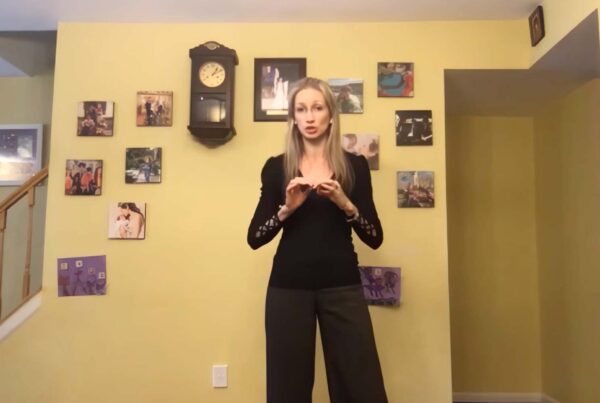When people first learn to dance, they are focused entirely on where to place the feet and what to do with the hands. It can be overwhelming at times. As they get more experienced, their focus moves beyond those basics to technique, musical timing, and leading or following. But one powerful aspect of dancing is often overlooked: the magic of spatial awareness.
Ballroom and Latin dances move around the floor, often in haphazard ways. Since the different couples on the floor are not doing identical step patterns at the same time, those movements can often conflict with other couples. At times, especially when you have multiple high-level competitive couples dancing a high-energy dance like Quickstep, it can seem almost a miracle that they don’t crash into each other more often!
Collisions are fairly common in ballroom dancing, but usually they aren’t a major concern. Yet I have seen people get in trouble, and suddenly they find themselves getting really familiar with the floor. I was even purposely tripped by another competitor during Slow Foxtrot in a Championship level competition. He saw me coming, looked right at me and stuck his foot out at the last second so that I would trip over it. Which I did. Fortunately, I was prepared enough to avoid a fall.
One year, during a competition event, multi-time professional ballroom champion Hazel Newberry was struck in the nose so hard that her nose began bleeding. She continued to dance, unfazed by the event.
So yes, collisions do happen, but the goal is to minimize these occasions. And that takes spatial, or situational, awareness.
Without awareness of the space around us, we can seem to others like a bull in a china shop. They have to watch out for us, which elevates the difficulty and stress level of everyone else on the floor. It’s similar to the way you feel when you’re driving and come across another driver who seems to be oblivious to the vehicles around him or her.
At times, especially fast dances, it can seem almost a miracle that couples don’t crash into each other more often!
Spatial awareness is much more than just trying to avoid collisions. It’s an essential element in being able to apply floor craft, that ability to instantly move into a different step pattern than you one you initially planned, based entirely on the changing space around you.
The top couples are masters of spatial awareness. I recall watching a Paso Doble a few years ago at the Canadian Championships, where national champs Anton and Antoinetta saw the space where they were planning to go fill in and masterfully switched to a series of side Chasses to avoid the obstacles, then continued on with their routine. To do something like this so fluidly in Paso requires an intimate knowledge of the musical phrasing, the skill to know how to replace your planned step pattern with another of the same number of beats, as well as awareness and complete trust by the lady.
Likewise, at the NDCC 2019 Canadian Championships in Gatineau Quebec, our national champions Richard and Claire, dancing a Slow Foxtrot, suddenly had another couple cut directly in front of their movement. Richard applied a Top Spin so smoothly and effortlessly that it looked like as if they had rehearsed exactly the same sequence a hundred times. It was beautiful to watch, an example of the highest level of skill in ballroom dancing.
Learning spatial awareness takes time and effort. Like any skill, you have to apply yourself to this with deliberate effort and practice.
When we were actively competing, one of our coaches would run drills where he would move around the floor to purposely get in our way while a number of couples were actively dancing. He would make it even more challenging by asking us questions at the same time, so that we would need to think of multiple things at once: our space on the floor, answering the question, the step patterns we were dancing, and our technique! It was great experience.
Eventually I was able to practically feel the air behind me, hearing the rustle of fabric or the brush of shoes on the floor to determine not only if someone was behind me, but how far away and what direction they might be moving, all of it while still dancing full out.
How do you become spatially aware?
The first step is to use your head to actually see what’s going on around you. There’s nothing wrong with looking around before starting a move that might cause problems behind you. Some step patterns, like There and Back in Cha Cha, require a quick look before you lead the figure. In fact, you need to know that there’s space behind your partner and yourself!
So keep your head on a swivel, especially on a crowded floor. Just don’t compromise your posture in the process.
Next, start to become aware of how others on the floor are using their space. You may find that some couples move more than others. If so, you may need to become more alert to where those fast-moving couples are. If you can’t see them anywhere in your line of sight, chances are they are behind you.
If you engage in competitor practice sessions, you might find yourself dancing with the same people frequently. In that case, take note of how their routines move in relation to yours. Start on the same side as they start to see if you end up getting into space issues. If so, switch those dances to start on the opposite corner to avoid trouble.
Eventually, with practice, you will begin to recognize how different step patterns fill up space and how much time you might have before an open space becomes a recipe for collision. Some patterns are danced frequently, so you can almost assume that if a couple is dancing a Fallaway Reverse Slip Pivot in Waltz, they are likely to continue with rotational figures like Double Reverse Spin, and then an Oversway. This gives you clues as to where the space will be a few seconds from the start of the sequence, and where space is likely to be filled.
The Partnership at work
One of the most important issues in managing spatial awareness is that of working together as a couple. Follows, do not hold back your lead when you notice a potential issue! I’ve had many ladies in social dancing slam on the brakes long before a potential collision, because they didn’t trust me to deal with what was happening behind me. When you freeze up and stop your partner you are not only showing a lack of trust, but also making it impossible for him to do whatever he may have been planning in order to avoid the problem. The best thing a follow can do is to gently squeeze the arm or connecting hand to indicate a potential issue and let him handle it.
If you’re serious about developing your skills as a ballroom or latin dancer, put some extra effort into developing your spatial awareness. You’ll find greater enjoyment in your dancing, as you become much more skilled at maneuvering around the floor. Best of all, others will love sharing the floor with you.
You may also like The lost art of floor craft













